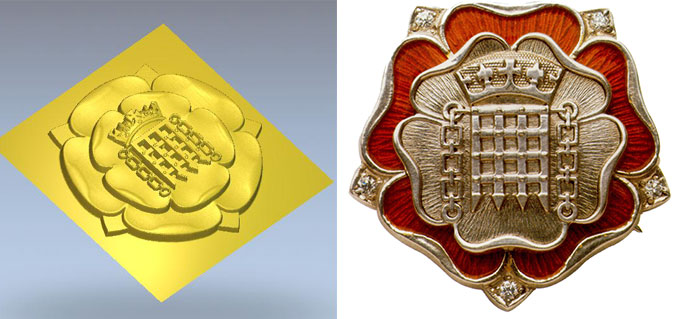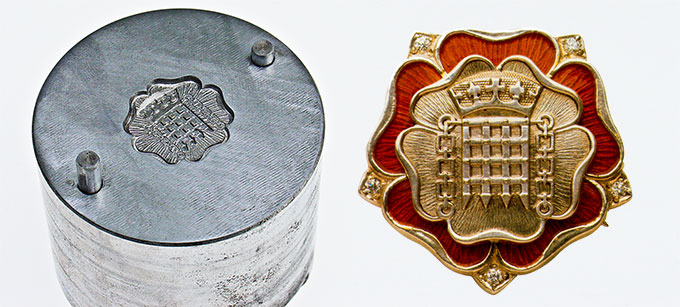The brooch was intended to bring together the symbols of the British Parliament, the Tudor rose, the portcullis and the crown into a unique design that was contemporary but incorporating the traditional character of the symbols from which it was composed.

Mr Serota created the design. He was experienced in creating jewellery with traditional methods, and therefore started the project with pencil and paper
At the drawing board
The project began with 2D designs made on a drawing board. To enhance the depth of the finished product, it was designed as two separately stamped roses, laid one over the other and soldered together. Colour and sparkle were introduced by red enamel on the lower rose and small diamonds on the edges of the leaves.
Once the design was complete, plaster models were made of the two roses, six times the full size of the intended end products. It was then that Mr Serota, the creator of the brooch, attended a Delcam seminar, at which he saw the huge possibilities ArtCAM offered him. Indeed, he commented:
It was a real eye opener. We saw how, from CAD models, computer-controlled machines could produce dies to a precision and quality that were almost unbelievable.
The finish was so fine that no subsequent handwork was necessary."
From then on, things were to go in a very different direction from the planned traditional die sinking process.
The traditional way
The conventional way to produce a die is to cast hard, enlarged, plastic female molds of the components and use these to cut female dies reduced to the size of the finished product. This is an extremely laborious process. The molds are placed in a pantograph milling machine, which has a stylus at one end and a rotating cutter at the other. Working by hand, the machine operator runs the stylus over the surface of the mold. The cutter responds with pre-determined, diminished movements over the block die, cutting the steel to the correct shape and size for the final product. The resulting female die is then hand finished to remove the striations left by the cutter. That's when Mr Serota discovered ArtCAM.
Mr Serota said of this process,
I really wasn't looking forward to this. It would have taken weeks of work to produce the four dies, and the results would have been nothing like so consistent as were produced using ArtCAM."
Traditions meet ArtCAM
Instead of doing weeks of hard work, the plaster models were scanned using a Renishaw Cyclone machine. Once the 3D data collected, Delcam converted it to 3D relief data using ArtCAM and ArtREAD.
The ArtCAM model was sent on to Howard Bros. (Engravers) Ltd, a specialist engraving company based in Birmingham. Howard Bros. (Engravers) Ltd has used Delcam's products for some time, and was a beta test site for ArtCAM. They modified the ArtCAM model, applying pips to the crown and adding a randomly generated texture to give the appearance of veins and lines on the rose petals.

Managing director of Howard Bros. (Engravers) Ltd, John Howard said,
The beauty of ArtCAM is that you can do all this work so quickly. With conventional methods, texturing had to be added using a matting punch which, in itself, took a couple of hours to make. Even then, the accuracy of the work was down to the skill of the person doing the work. With ArtCAM, you call up the relief design that you want, colour-code the areas of the model to which the texture is to be applied, and the rest is done automatically. What's more, every repeat of the relief is identical."
One of the greatest benefits of ArtCAM, said Mr Howard, is that it allows engravers to show their customers a print-out of their designs before any metal is cut.
By the time you have made a model it's too late. This way, you don't commit until you are absolutely certain that the customer is satisfied - essential in the jewellery business, which is all about subjective judgements and individual taste."
Howard Bros. (Engravers) Ltd created a same size male model of the punch: A single ArtCAM command inverted the details and created a second, female model for the die.
Again using ArtCAM, Howard Bros. (Engravers) Ltd calculated the roughing and finishing toolpaths for the molds. They also scaled the models to allow for the thickness of the materials to be used. They then transferred these to a Kuhlmann Polaris CNC machine, set a block of stamping quality Grane steel in the tool, did the roughing in an afternoon, and then left the machine working overnight for finishing. "By the time I arrived at work next morning, I had the finished punch," says John Howard. "I repeated the process the following afternoon and night for the die." The finishing process actually took about five hours per item.
The advantage of working this way rather than with the old, manual techniques is repeatability. With a model produced in ArtCAM, you can produce any number of identical punches and dies. This means that, if you accidentally break a die, you can produce another one exactly the same."
Finally, a London firm produced the stampings by placing a layer of silver between the punch and the die and applying 70,000KG (154,000Lb) pressure. The work the returned to Mr Serota.
Weeks of Work Saved

Mr Serota spent a morning cutting the roses from the dies with a fretsaw and hand finishing the edges. He then used a specialist to add the enamelling, a jeweller and diamond mounter to assemble the brooch, and finally a setter to add the diamonds.
When it was all assembled, I was amazed at the sharpness of the outlines produced by the process, which had really enhanced my original design.
Using ArtCAM saved weeks of work, and I could not have achieved the same quality of finish using manual techniques. In fact, if I had realised it at the time, I need not even have made plaster models of the roses: ArtCAM could have handled it all from the original drawings."
Mr Serota concludes:
ArtCAM itself could make a huge difference even to craftsman jewellers working on one-off pieces. The ability to take a 2D drawing and convert it automatically into a 3D model would be a valuable tool, since it would allow people to visualise their designs and adapt them before cutting into expensive metals."
As a result of seeing the finished Lords Brooch, a prestigious London jewellery firm has approached Delcam. Recognising that ArtCAM can be used to design and manufacture moderate runs of high quality products, the firm is investigating how best they can employ this innovative technology in their business.
